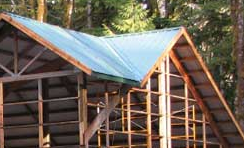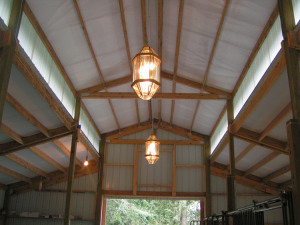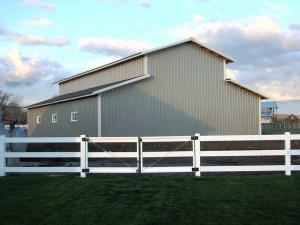Nothing is worse than a roof gone wrong. Leaks frustrate everyone involved, and are usually avoidable. Poor design and poor installation are equal factors in the roofs which just are not happy.
Avoid Valleys
 Designing the roof of a pole barn? Then try to design a roof without any valleys. Valleys concentrate water and often clog with ice. It’s far more common to have leaks or ice dam problems near valleys than in the middle of a simple gabled roof. Many valleys exist because of a designer’s conceit rather than necessity. Often, these valleys trace back to the mistaken belief a chopped-up, complicated, multi-plane roof looks better than a simple gable. It doesn’t. And more complicated roofs are more expensive.
Designing the roof of a pole barn? Then try to design a roof without any valleys. Valleys concentrate water and often clog with ice. It’s far more common to have leaks or ice dam problems near valleys than in the middle of a simple gabled roof. Many valleys exist because of a designer’s conceit rather than necessity. Often, these valleys trace back to the mistaken belief a chopped-up, complicated, multi-plane roof looks better than a simple gable. It doesn’t. And more complicated roofs are more expensive.
Just say no to Dormers and Skylights
 No good reason exists for a new pole building to have a dormer. When I see a dormer, I conclude the designer or the architect made a mistake. They didn’t include enough interior space, and the building owner was forced to cut a hole in the roof because the ceiling was too low to stand up. Want to build a multi-story pole building – no problem. Want two floors, build two floors. Want three floors, build three floors. Then build a roof over the top floor. This roof should not have any deliberate holes in it. The “no holes” rule covers both dormers and skylights. Skylights are an invitation to leak – no matter how great the flashing kit is, pretty well plan upon them leaking, if they don’t it is a surprise bonus.
No good reason exists for a new pole building to have a dormer. When I see a dormer, I conclude the designer or the architect made a mistake. They didn’t include enough interior space, and the building owner was forced to cut a hole in the roof because the ceiling was too low to stand up. Want to build a multi-story pole building – no problem. Want two floors, build two floors. Want three floors, build three floors. Then build a roof over the top floor. This roof should not have any deliberate holes in it. The “no holes” rule covers both dormers and skylights. Skylights are an invitation to leak – no matter how great the flashing kit is, pretty well plan upon them leaking, if they don’t it is a surprise bonus.
In most cases Single Slope Roofs are not less expensive
They also create a very tall wall on one side of the building, which has to be engineered for. Lots of “dead air” space ends up being paid for. There is not a ridge which can be easily vented. Worst of all – most people find them aesthetically unattractive.
An Unconditioned Vented Attic is better than an Insulated Roof
It makes more sense to put insulation on a flat ceiling than to try to insulate a sloped roof, for several reasons. Purlins usually aren’t deep enough to hold a thick layer of insulation; on the other hand, it’s usually easy to add a deep layer of insulation to the attic floor. Insulating the attic floor is also cheaper. Leave the space between purlins uninsulated, it will be easier to locate roof leaks. It is easier to air seal a flat ceiling, rather than a vaulted ceiling. If roof sheathing is used, damp roof sheathing will dry out quicker if it faces an attic than if it is part of a cathedral ceiling.
The Best Roof Shape is a simple Gable Roof
In a cold climate, the ideal design is a simple gable. Since gables don’t have any valleys or hips, they are easy to vent. It’s a straight shot from the soffits to the ridge. Chopped-up roofs with a variety of intersecting planes are hard to frame, hard to keep watertight, and hard to vent. Every nook and cranny creates somewhere for tree needles and ice to accumulate.
In a hot climate, a hipped roof can make more sense than a gable, because a hipped roof makes it easier to provide shade on all four sides of the pole barn. In a hot climate, shade is good. Fortunately, people in hot climates rarely have to worry about ice dams.
In all climates, make overhangs generous. If building a gable roof, don’t forget the rake overhangs; most rake overhangs are too stingy. Frame the rake overhang with overhanging purlins.
Don’t reduce the Roof Slope between the Ridge and the Eave
 A good roof plane has a consistent slope from the ridge to the eave. A roof which changes slope at midpoint is disturbing. Especially disturbing is a steep roof which suddenly switches to a shallow pitch (for example, when a porch with a shallow-pitched roof is affixed to a pole building with a steep roof). Shallow slopes hold snow and are susceptible to leaks. Most steel roofing warranties are void on slopes of less than 3/12.
A good roof plane has a consistent slope from the ridge to the eave. A roof which changes slope at midpoint is disturbing. Especially disturbing is a steep roof which suddenly switches to a shallow pitch (for example, when a porch with a shallow-pitched roof is affixed to a pole building with a steep roof). Shallow slopes hold snow and are susceptible to leaks. Most steel roofing warranties are void on slopes of less than 3/12.
Make sense so far? Come back Monday when I finish up on my recommendations for making your roof affordable, long lasting, and pleasing to the eye.






